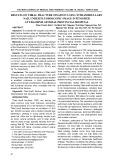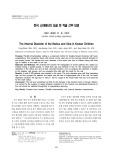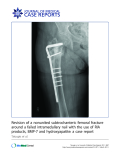
THAI BINH JOURNAL OF MEDICAL AND PHARMACY, VOLUME 16, ISSUE 2 - MARCH 2025
50
1. Thai Binh University of Medicine and Pharmacy
2. Thai Binh Provincial General Hospital
*Corresponding author: Phan Thanh Nam
Email: phanthanhnamytb@gmail.com
Received date: 17/2/2025
Revised date: 20/3/2025
Accepted date: 25/3/2025
RESULTS OF TIBIAL FRACTURE FIXATION USING INTRAMEDULLARY
NAIL UNDER FLUOROSCOPIC IMAGE INTENSIFIER
AT THAI BINH GENERAL PROVINCIAL HOSPITAL
Phan Thanh Nam1*, Vu Minh Hai1, Nguyen The Diep1, Nguyen Duc Tai2,
Nguyen Van Dung2, Luu Duc Hai2, Do Thi Huyen2
ABSTRACT
Objective: To evaluate the surgical outcomes of
tibial fracture fixation using an intramedullary nail
under fluoroscopic guidance at Thai Binh Provincial
General Hospital in 2023.
Methods: A cross-sectional study was conducted
on 89 patients from September 2022 to March 2023
at the Department of Orthopedics and Burns, Thai
Binh Provincial General Hospital.
Results: The mean postoperative hospitalization
duration was 3.64 ± 0.99 days. Superficial infections
occurred in 3.4% of cases, with no deep infections
or chronic osteomyelitis. Most patients achieved
excellent surgical outcomes, bone healing, and
functional recovery at rates of 93.3%, 97.8%, and
92.1%, respectively.
Conclusion: The surgical fixation of tibial shaft
fractures using a closed intramedullary nail with
locking screws under fluoroscopic guidance resulted
in excellent outcomes, a short postoperative
period, and minimal complications. Bone alignment
and functional recovery were correlated with the
severity of the fracture.
Keywords: Tibial shaft fracture, bone fixation,
intramedullary nail, fluoroscopic imaging.
INTRODUCTION
Tibial shaft fractures (TSF) are among the
most common long bone fractures, accounting
for approximately 2% of all fractures in adults [1].
Tibial shaft fractures have an incidence of 16.9
per 100,000 annually, with a distinct bimodal age
distribution, peaking in young adults around 20
years old, often due to high-energy trauma such
as motor vehicle accidents, and in older adults
near 50 years of age, typically resulting from low-
energy falls [2]. The tibia’s subcutaneous position
and limited soft tissue coverage present unique
challenges in the management of these fractures,
influencing both treatment choice and outcomes.
Due to unique anatomical characteristics and
varying injury mechanisms, the extent of damage
in TSF is highly diverse. Accurate assessment
of anatomical damage is crucial for determining
appropriate treatment.
Currently, the treatment of TSF varies depending
on the type and location of the fracture. The
trend in TSF treatment is towards minimally
invasive surgery, with closed reduction and locked
intramedullary nailing being widely used. This
technique is less invasive, minimizes soft tissue
damage, and preserves hematomas essential for
fracture healing. It has advantages such as good
bone healing, early functional recovery, fewer
complications, and minimal scarring. However, a
proportion of patients still experience infections,
delayed healing, and moderate functional recovery.
Intramedullary nailing (IMN) has become the
gold standard for treating tibial shaft fractures due
to its biomechanical advantages, including load-
sharing stability, minimal soft tissue disruption, and
high union rates [3]. Compared to plate fixation
or external fixation, IMN allows for earlier weight-
bearing and lower infection rates, particularly in open
or comminuted fractures. The procedure is typically
performed under fluoroscopic guidance, which aids
in accurate nail placement, fracture reduction, and
avoidance of malalignment. However, challenges
such as radiation exposure, technical difficulties in
proximal/distal fractures, and postoperative knee
pain remain concerns.
In Vietnam, particularly at Thai Binh Provincial
General Hospital, IMN is increasingly used for tibial
fractures, but local data on surgical outcomes,
complications, and patient recovery are limited.
Most existing studies come from high-income
countries, and results may not fully reflect the
socioeconomic conditions, patient demographics,
and surgical resources in Vietnamese healthcare
settings. Therefore, evaluating the efficacy, safety,
and functional outcomes of closed IM nailing under
fluoroscopy in this context is essential for optimizing























